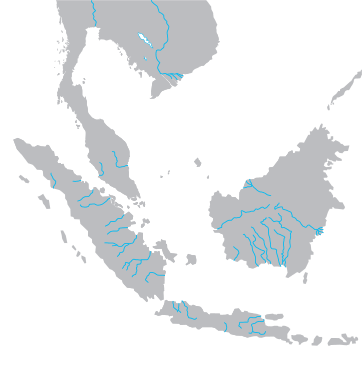 |
| Srivijaya through time |
Srivijaya was founded in Palembang in southern Sumatra, an island now part of Indonesia, in the 7th century CE; at its height the empire exerted political and economic dominance over the Sumatra, Java, and the Malay Peninsula, the most populous regions of modern Malaysia and Indonesia. It was founded on the heels of the first major foothold of Indian culture and trade in Southeast Asia, and due to its strategic position near major sea passages it quickly became a powerful broker of trade between the twin behemoths of India and China. At one time the king of Srivijaya was renowned as wealthier and more powerful than any maharaja in India.
At the same time, it was a potent cultural vector, largely responsible for the spread of Mahayana Buddhism and the technology of writing throughout mainland Southeast Asia and the Indonesian Archipelago, and established Malay as the common trade language of the entire region; many of the most deeply-rooted cultural currents in modern Southeast Asia can be traced to this era.
 |
| Bas-relief scene at Mahayana Borobudur temple, built in Java by the ruling Sailendra dynasty of Srivijaya |
So why was the Srivijayan civilization so thoroughly lost to time? The proximal reason is that an astonishingly small amount of physical evidence was left behind. Unlike other major empires, its political legacy seemingly dissolved immediately after its fall. Local history quickly forgot, and much of the evidence we have about the existence of the empire is from external sources, writings by the Chinese and the Abbasids who visited on missions of trade or religion, and these could not be tied definitively to archaeological evidence until the discovery of a few stone inscriptions in 1920, the only permanent records left.
| The Chinese monk Yijing wrote one of the most substantial accounts about the empire. |
 |
| Kedukan Bukit inscription, oldest attested sample of Malay language |
In order to understand the deeper reasons for this, we have to examine the actual structure of the organization. It was a thalassocracy built upon a so-called mandala model, a political geometry very different from that of the Romans or the Chinese. Unlike these more familiar examples, Srivijaya had no core homeland, never based upon the possession of terrestrial territory or agricultural powerhouse. It was primarily maritime and international trade sat squarely at the center of the economy; it thus existed entirely as a federation of port cities, with the seat of power shifting as quickly as the tides.
While it did exert military control to strike out dangerous rivals, the powers at the center were never bent on managing every last strip of land in their grasp, but rather establishing tributary relationships with regional rajas in a loose network of alliance and economic subservience. As a result, it never really had an ethnic base or any permanent bureaucracy. When it died, it was not at the hands of a catastrophic conquest but the erosion of influence among regional powers who merely flipped allegiances without major upheaval of people or trade networks. After centuries of setting the economic and cultural tone of Southeast Asia, its influence dissipated within a few generations, giving way to Kediri, the Majapahit Empire, and the Sultanate of Malacca, and without successors to write its histories in years to come it was simply forgotten.
 |
The ruined Wat Kaew temple |
Further reading:
Wikipedia
FindTheData (an interesting statistical resource)
Global Security
What's a thalassocracy?
What's a mandala federation?
Sailendra dynasty, a prominent ruling family
Yijing, the Chinese monk who visited in the 7th century
Malacca Sultanate, the claimed successor state
the book I picked up in a Dutch bookstore
No comments:
Post a Comment